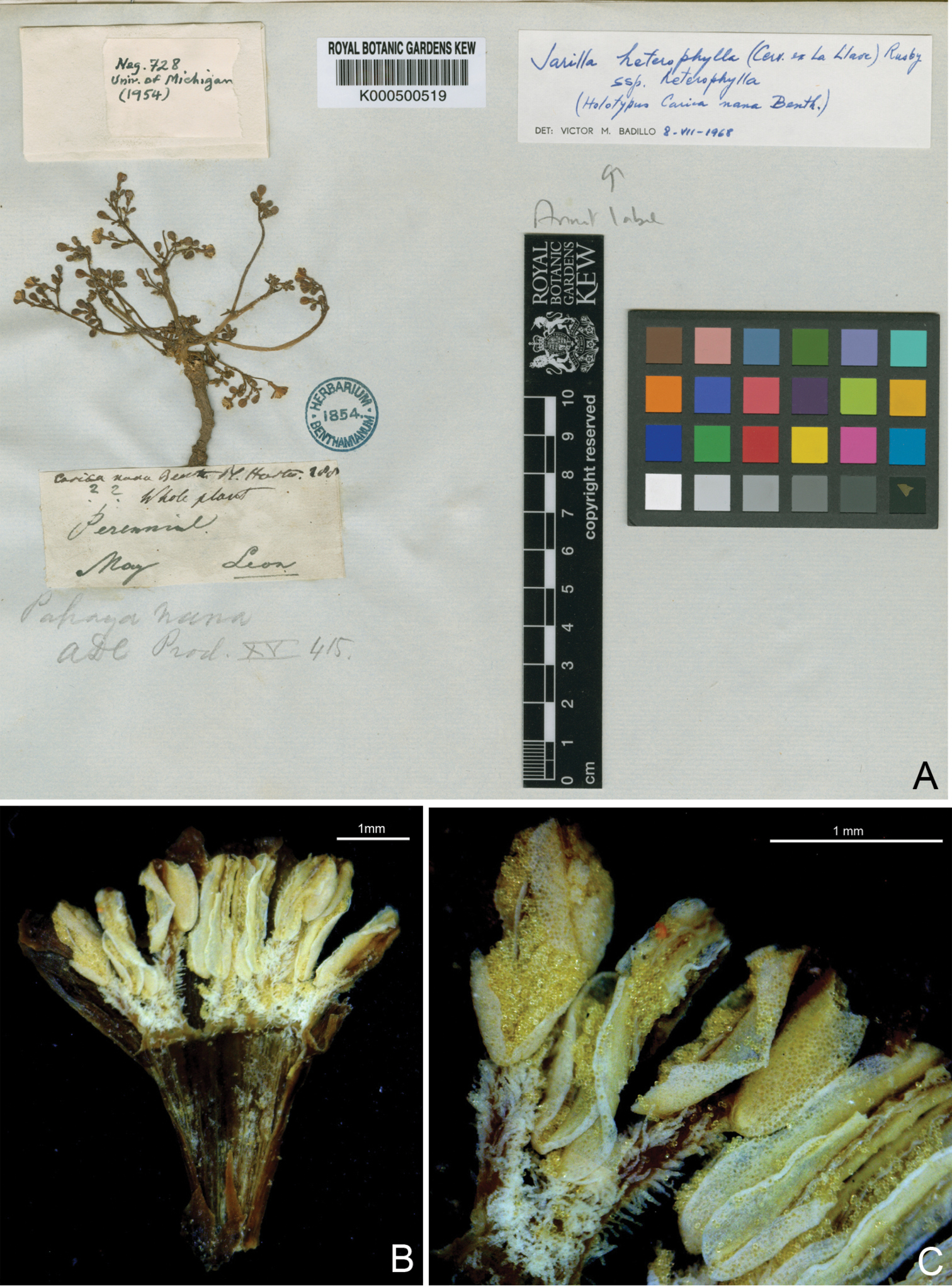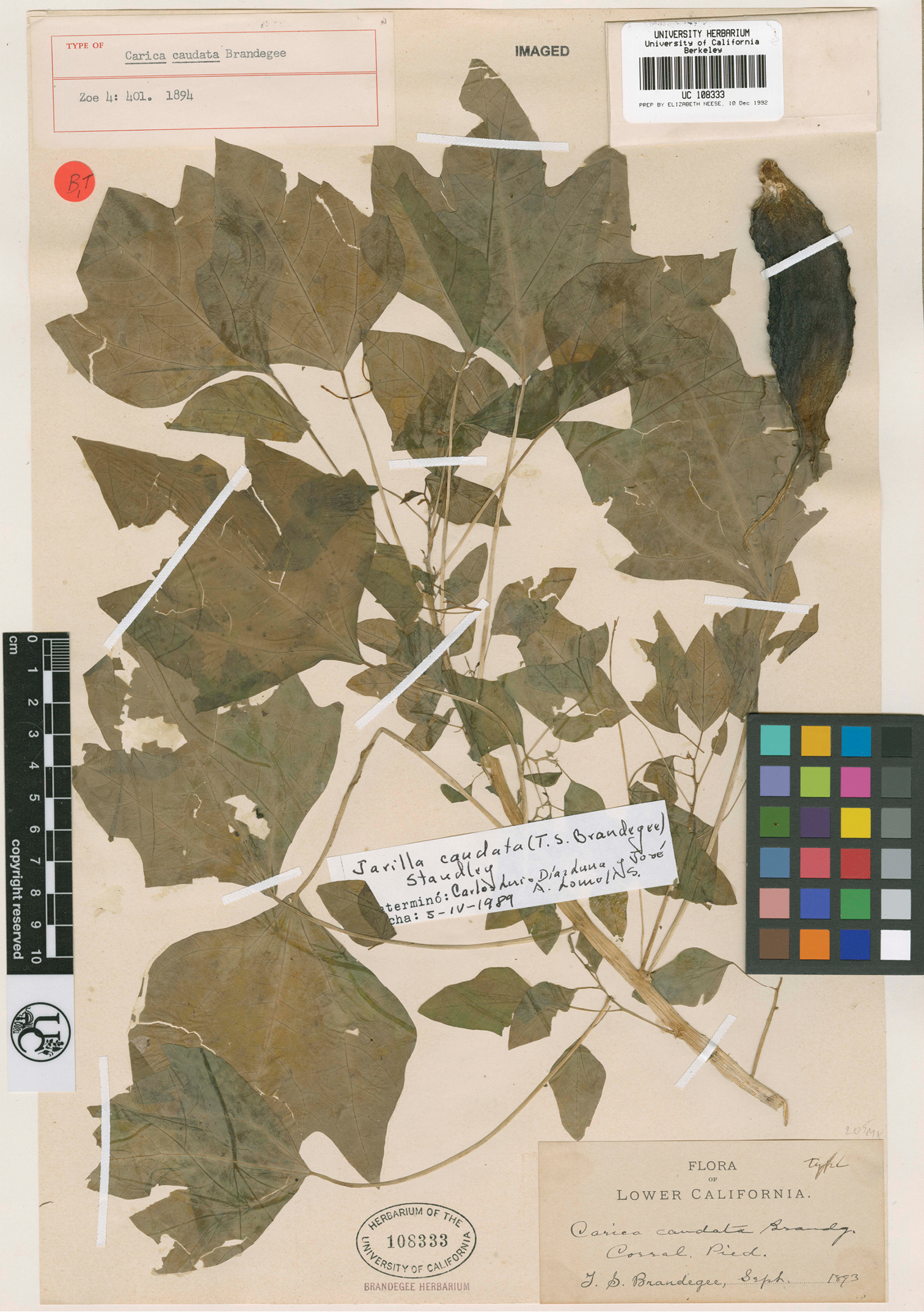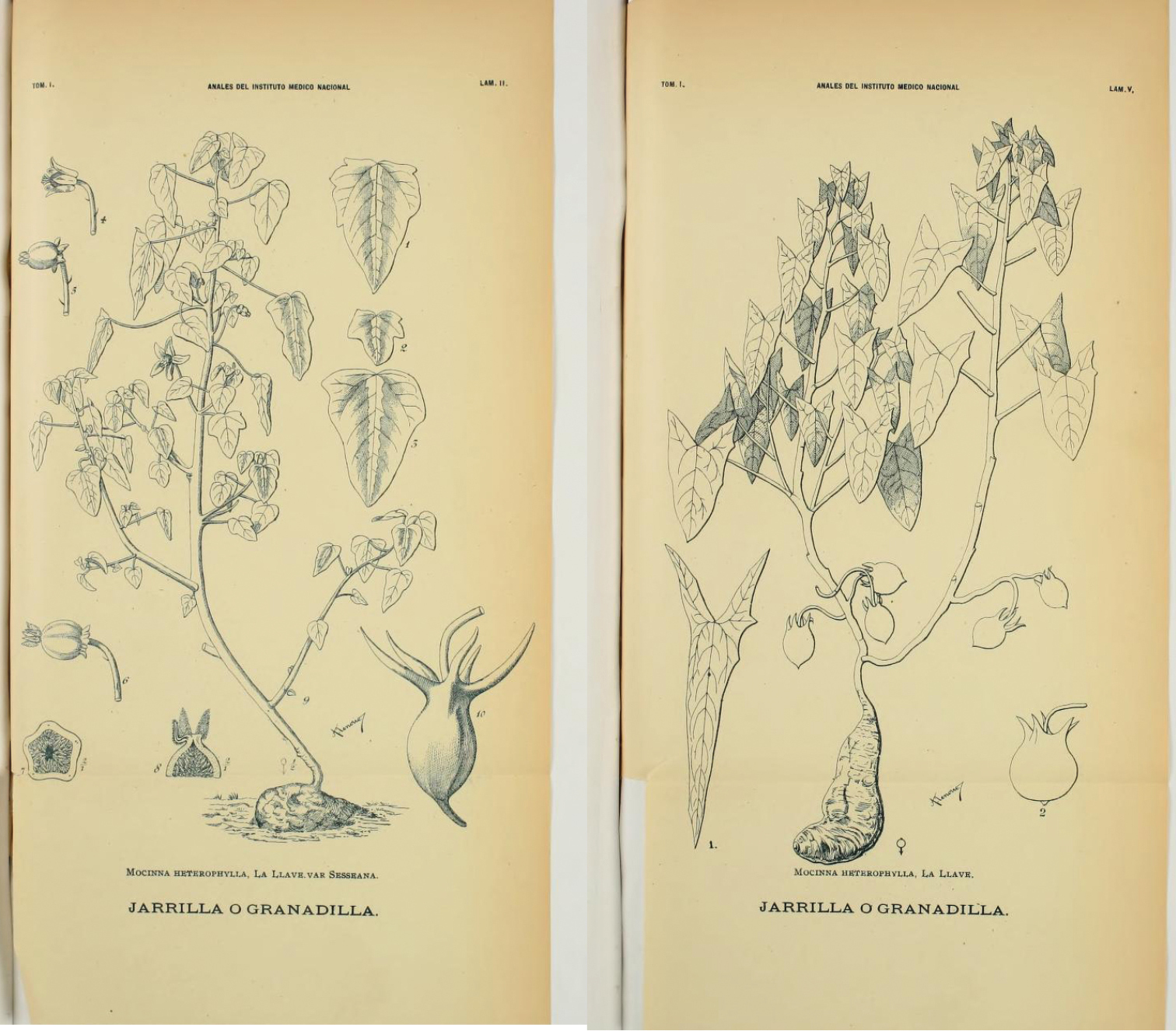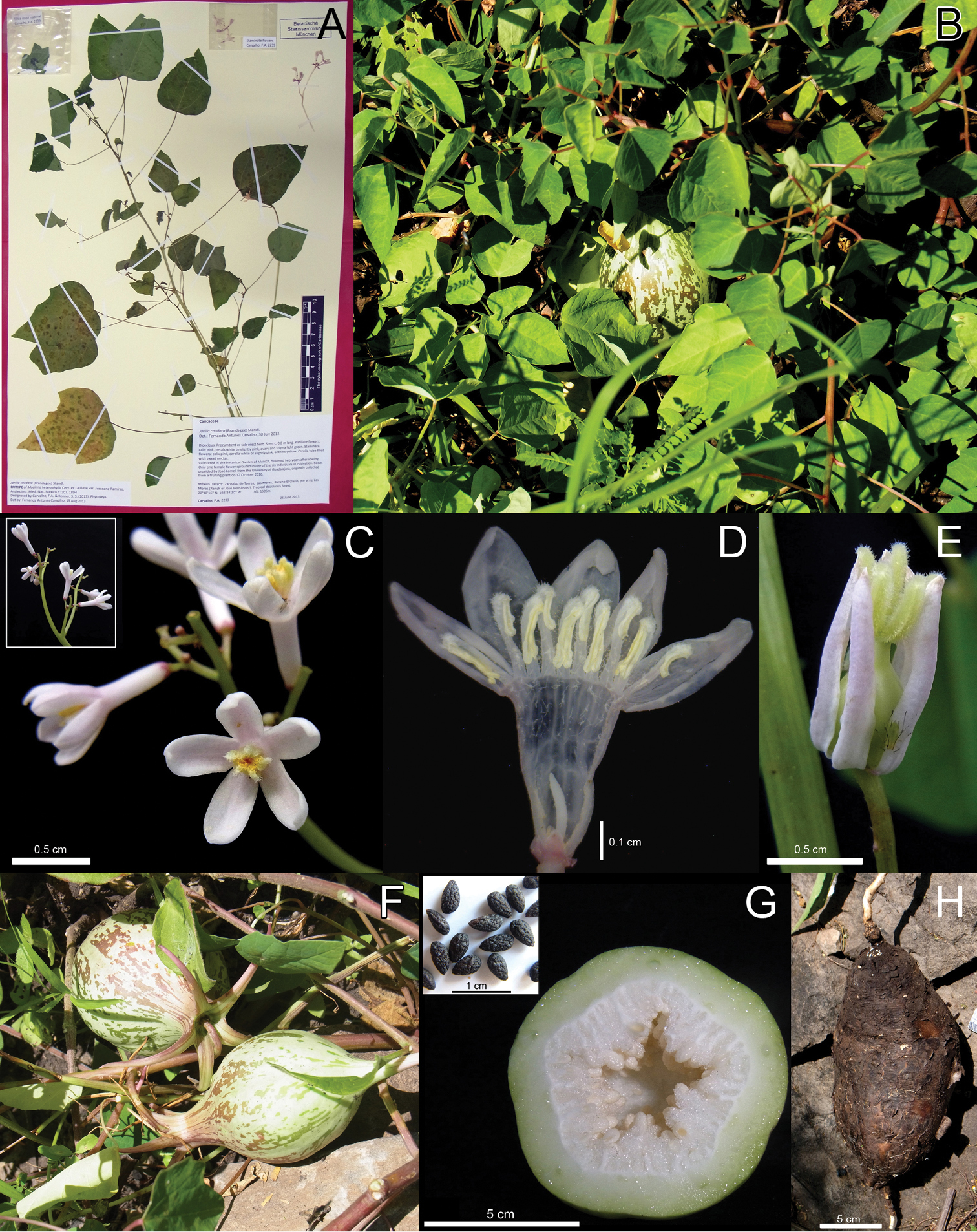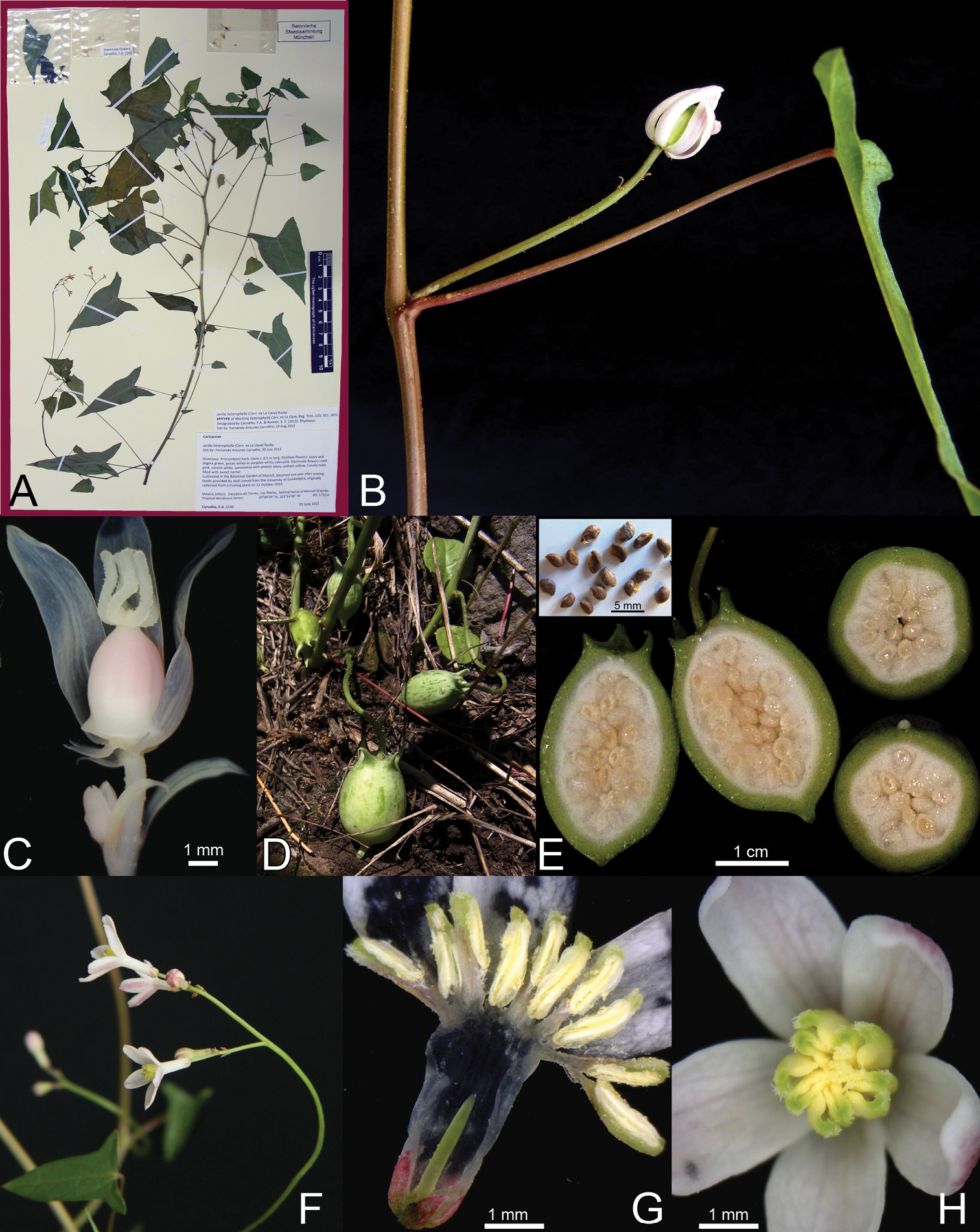






(C) 2013 Fernanda Antunes Carvalho. This is an open access article distributed under the terms of the Creative Commons Attribution License 3.0 (CC-BY), which permits unrestricted use, distribution, and reproduction in any medium, provided the original author and source are credited.
For reference, use of the paginated PDF or printed version of this article is recommended.
Citation: Carvalho FA, Renner SS (2013) Correct names for some of the closest relatives of Carica papaya: A review of the Mexican/Guatemalan genera Jarilla and Horovitzia. PhytoKeys 29: 63–74. doi: 10.3897/phytokeys.29.6103
Using molecular data, we recently showed that Carica papaya L. is sister to a Mexican/Guatemalan clade of two genera, Jarilla Rusby with three species and Horovitzia V.M. Badillo with one. These species are herbs or thin-stemmed trees and may be of interest for future genomics-enabled papaya breeding. Here we clarify the correct names of Jarilla heterophylla (Cerv. ex La Llave) Rusby and Jarilla caudata (Brandegee) Standl., which were confused in a recent systematic treatment of Jarilla (
Caricaceae, nomenclature, epitypification, papaya sister clade
The family Caricaceae Dumort. comprises 34 species and one formally named hybrid in currently six genera. A molecular phylogeny that included all species revealed that Carica papaya L. (the only species in the genus Carica) is sister to a clade of four species endemic to Mexico and Guatemala (
We start with the nomenclatural issues, then provide a key to the four species, and end with brief comments on the range and habitat of each species.
Pablo de
The second herbaceous Caricaceae species was named in March 1894 by Townshend S. Brandegee, who described Carica caudata from the Cape region of Baja California, Mexico, based on a plant he collected the year before (Fig. 2). In August of the same year, José Ramírez, unaware of Brandegee’s publication, described a new variety of the first herbaceous Caricaceae, Mocinna heterophylla La Llave, naming it varietas sesseana, based on living plants from Guanajuato and Jalisco. Unfortunately, he appears to have made no herbarium specimens, but only two beautiful plates showing the typical variety and var. sesseana (Fig. 3). Comparison of the plate of var. sesseana and the holotype of Carica caudata leaves no doubt that these names refer to the same species, and we therefore agree with previous assessments (
Realizing that Mocinna La Llave was a younger homonym of Mocinna Lag., Henry Hurd
Thus, by 1937 it was clear there were three species of Jarilla and also what their correct names were. In their revision of the genus,
We agree with
To fix the usage of the two names more reliably, we below designate epitypes to serve as interpretative specimens for plates II and V of
The four species in the Jarilla/Horovitzia clade can be distinguished from all other Caricaceae and from each other, using a combination of the plastid markers trnL-trnF and psbA-trnH (
| 1a | Small tree, completely covered by stinging hairs | Horovitzia cnidoscoloides |
| 1b | Herb, glabrous or pubescent, but never with stinging hairs | 2 |
| 2a | Erect herb. Leaves lobate, rarely entire. Ovary and mature fruits with 5 longitudinal wings. Female flowers 7–9 mm long. Male flowers 5–9 mm long | Jarilla chocola |
| 2b | Procumbent herb, sometimes using understory plants for support. Leaves entire, rarely lobed. Ovary and young fruits with 5 basal appendages, but not winged. Female flowers 5–15 mm long. Male flowers 4-12 mm long | 3 |
| 3a | Mature fruits 6–30 cm long with 5 horn-like basal appendages 3–6 cm long. Seeds black, 4–5.5 mm long. Male flowers in general >1 cm (1–1.7 cm) | Jarilla caudata |
| 3b | Mature fruits 2–4 cm long with 5 curved basal appendages 0.5–2 cm long. Seeds light brown, 2.5–3.5 mm long. Male flowers in general <1 cm (0.3–0.8 cm) | Jarila heterophylla |
Holotype of Carica nana Benth. A Specimen in K (http://www.kew.org/herbcatimg/202388.jpg ) B Photo of an opened flower showing the arrangement of the anthers and the pistillode (arrow) C Close-up of the anthers. Filaments are densely covered by moniliform trichomes. B and C were taken by the first author in K.
Holotype of Carica caudata Brandegee (http://ucjeps.berkeley.edu/new_images/UC108333.jpg )
The two varieties of Mocinna heterophylla La Llave. Left plate shows the lectotype of Mocinna heterophylla var. sesseana Ramírez. Right plate shows the neotype of Mocinna heterophylla var. heterophylla, both designated by Díaz and Lomeli-Sención (1992). Plates reproduced from
http://species-id.net/wiki/Horovitzia_cnidoscoloides
Mexico. Oaxaca: Ixtlan, Sierra de Juárez, 9 March 1986, R. Torres & P. Teonorio 8168 (holotype: MEXU, a photo in GUADA; isotypes: BM, MO [MO-193213], NY[00112155]). Mexico. Oaxaca. Type locality, 25 May 1883, T. Cedillo & Lorence 2347 (paratype: MEXU, a photo in GUADA, a duplicate in MO); 4 Ago 1985, Lorence et al. 4733 (paratype: MEXU, a duplicate in BM); 9 Mar 1985, C. Torres & L. Tenorio 8167 (paratype: MEXU); 27 Ago 1986, C. Torres & L. Tenorio 8760 (paratype: MEXU).
Horovitzia cnidoscoloides is a small tree, 0.5–4 m tall endemic to Sierra de Juarez in Oaxaca, Mexico. It occurs in cloud forests from 800 to 1600 m above sea level. Unusual features are subcapitate stigma, and stinging hairs covering the entire plant.
Mexico. Sonora: Chihuahua, Guasarema, Rio Mayo, 10 August 1936, H. S. Gentry 2366 (holotype: F; isotypes: GUADA photo, K [K000500520], S [S-G-3434]). Mexico. Sonora: San Bernardo, Rio Mayo, 14 August 1935, H. S. Gentry 1624 (paratype: F, duplicates in MEXU and K [000500521], a photo in GUADA).
Jarilla chocola is an erect herb, with mostly lobate leaves and fruits with 5 longitudinal wings. The species occurs at low altitudes (100–1300 m) along the Pacific Coast from Sonora to El Salvador.
http://species-id.net/wiki/Jarilla_caudata
Fig. 4Jarilla caudata is morphologically and phylogenetically closely related to Jarilla heterophylla. Their main distinguishing features are the fruits, which in Jarilla caudata can attain a length of 30 cm, having a smooth surface and 5 long, horn-like appendages (3–6 cm long). Other differences are given in the key. The species occurs in deciduous forests and fields of Baja California and central Mexico from 1500 to 1800 m above sea level.
Jarilla caudata (Brandegee) Standl. A Epitype of Mocinna heterophylla La Llave (F.A. Carvalho 2240, M) B Habit C Male inflorescence D Staminate flower. E Pistillate flower F Fruits G Ovary unilocular and seeds H Tuber.
http://species-id.net/wiki/Jarilla_heterophylla
Fig. 5For differences from Jarilla caudata see under that species and in the key. Jarilla heterophylla occurs in oak forests, deciduous forests, and abandoned fields of central Mexico at 1500 to 2700 m above sea level.
Jarilla heterophylla (Cerv. ex La Llave) Rusby. A Epitype of Mocinna heterophylla La Llave var. sesseana Ramírez (F.A. Carvalho 2239, M) B Female inflorescence (uniflora). C Female flower showing the short appendages at the base of the ovary D–E Fruits and seeds F male inflorescence G–H Staminate flowers.
Carica caudata Brandegee, holotype:
http://ucjeps.berkeley.edu/new_images/UC108333.jpg [accessed 30.07.2013]
Carica cnidoscoloides Lorence & R. Torres, isotypes:
http://www.tropicos.org/Image/11116 [accessed 11.08.2013]
http://sweetgum.nybg.org/vh/specimen.php?irn=707429 [accessed 11.08.2013]
Carica nana Benth., holotype:
http://www.kew.org/herbcatimg/202388.jpg [accessed 30.07.2013]
Jarilla chocola Standl., isotypes:
http://apps.kew.org/herbcat/getImage.do?imageBarcode=K000500520 [accessed 11.08.2013]
http://andor.nrm.se/kryptos/fbo/kryptobase/large/S-G-003001/S-G-3434.jpg [accessed 11.08.2013]
Mocinna heterophylla Cerv. ex La Llave, epitype:
http://herbaria.plants.ox.ac.uk/bol/caricaceae [accessed 11.10.2013]
Mocinna heterophylla var. sesseana Ramírez, epitype:
http://herbaria.plants.ox.ac.uk/bol/caricaceae [accessed 11.10.2013]
We thank J. F. Barêa Pastore for discussion of the nomenclature of Jarilla, and the herbaria K, MO, NY, S, and UC for providing open access to type images. The first author is supported by a fellowship from Conselho Nacional de Desenvolvimento Científico e Tecnológico (CNPq 290009/2009-0), and additional funding came from the German Research Foundation (DFG RE 603/13).
